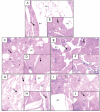Structural and Techno-Functional Properties of Bovine Collagen and Its Application in Hamburgers
- PMID: 31866750
- PMCID: PMC6902288
- DOI: 10.17113/ftb.57.03.19.5896
Structural and Techno-Functional Properties of Bovine Collagen and Its Application in Hamburgers
Abstract
The objective of this work is to characterize two types of bovine collagen (fibre and powder), evaluating its application in mixed hamburger formulations, as well as the quality characteristics of the products. The collagen fibre had a fibrillar structure, molecular mass 100 kDa and greater gel strength (146 315 Pa) and protein content (97.81%) than the powdered collagen, which had molecular mass from 50 to 100 kDa, greater hydroxyproline content, and a morphological structure with spherical microparticles more amorphous than the collagen fibre. In this study we found that the addition of 1.5% powdered collagen and 2.5% flocculated soybean flour and/or 0.75% powdered collagen and 3.5% flocculated soybean flour did not deteriorate the technological properties or the sensory attributes of hamburgers. The use of collagen is a promising alternative, since it has functional properties, improves the texture characteristics of a product, and is of low cost.
Keywords: collagen; gel strength; hamburger; soybean flour; technological properties.
Figures





References
-
- Normative Instruction no. 20, July 31, 2000. Technical regulation of identity and quality of hamburger. Ministry of Agriculture Livestock and Food Supply, Brasília, DF, Brazil: Official Gazette of the Federative Republic of Brazil; 2000 (in Portuguese).
-
- Schmidt US, Pietsch VL, Rentschler C, Kurz T, Endreß HU, Schuchmann HP. Influence of the degree of esterification on the emulsifying performance of conjugates formed between whey protein isolate and citrus pectin. Food Hydrocoll. 2016;56:1–8. 10.1016/j.foodhyd.2015.11.015 - DOI
-
- Schilling MW, Marriott NG, Acton JC, Anderson-Cook C, Alvarado CZ, Wang H. Utilization of response surface modeling to evaluate the effects of non-meat adjuncts and combinations of PSE and RFN pork on water holding capacity and cooked color in the production of boneless cured pork. Meat Sci. 2004;66(2):371–81. 10.1016/S0309-1740(03)00123-2 - DOI - PubMed
-
- Ferraro V, Anton M, Santé-Lhoutellier V. The “sisters” α-helices of collagen, elastin and keratin recovered from animal by-products: Functionality, bioactivity and trends of application. Trends Food Sci Technol. 2016;51:65–75. 10.1016/j.tifs.2016.03.006 - DOI
LinkOut - more resources
Full Text Sources
Research Materials
